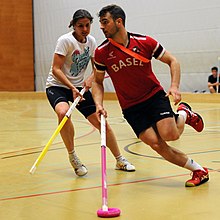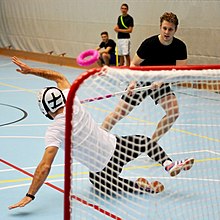Donut hockey
Donut hockey is a team sport from the genre of goal scoring games. The game combines and integrates elements from the established sports of ice hockey , floorball and the Canadian ringette into a new, fast indoor sport and is aimed at people of all ages. The rules and material of the game were developed by the Swiss company Burner Motion , a corresponding textbook was written by the sports teacher and author Muriel Sutter and published in 2017 by Hofmann-Verlag . So far , donut hockey has been most widespread in Switzerland , but is also being played and taught in the Netherlands , Germany , Austria , Italy , Finland , Latvia , Lithuania and Taiwan .
history
In the 1990s, the widespread boom of the sport Floorball ( Floorball ) in Europe . Since playing with the small ball is technically demanding, the alternative game idea "ring hockey" with inverted sticks or gymnastic sticks and rubber rings was presented in various textbooks and training courses . The ringette was launched in Canada as early as 1963 and subsequently established as a recognized winter sport. The rules are similar to those in ice hockey, but Ringette does not require any physical contact. The game is played with a grooved ring and a stick with a stepped tip. This combination enables precise interaction as well as fast, accurate shots.
The idea behind Donut Hockey is to combine these two sports into a new game variant that can be played easily and without expensive protective equipment . In order to meet the requirements of a sport suitable for school and leisure time , material that was suitable for indoor use had to be developed first, which enables an attractive game without stressing the hall floor. In cooperation with various Swiss universities and secondary schools , appropriate sticks with special tips, a soft and excellent gliding " donut " and a goalkeeper mask with a special visor were developed. At the same time, an official textbook Donut Hockey - Fast Food For Fast People (2017) with rules, technique and tactics as well as a variety of game and training ideas was created .
Game idea
Donut hockey is played on a playing field with three field players and one goalkeeper per team and is directed by a referee . The rules are made up of floorball, ringette and ice hockey. A soft, slippery ring (donut) is using sticks dribbled , fit and fired into an opponent's goal. Since the control of the donut requires hardly any technical skills and the view can be taken away from the play equipment without any problems, donut hockey enables relatively quick progress and efficient participation in the team, especially for beginners. Both the physical intensity and the individual and team tactical variety of the game increases with increasing skills . As a technically simple but intensive game sport, Donut Hockey encourages movement, trains the physical performance as well as the coordinative and tactical skills of the participants and at the same time promotes lasting fun in team sports.
regulate
The indoor sport of donut hockey is usually played on a small field. A goal area delimits the zone, in which the goalkeeper is allowed to be on his knees and without a stick, as in floorball,to fend off or catch the donut with all parts of the body. Goals can only be scored from outside this goal area. A field player may stop the donut with his foot and put himself forward. High passes or shots may also be accepted with the body or hit to the ground with the hand. Moderate physical exertion to obtain the donut is permitted within the framework of the regulations. Body checks with shoulder or hip are only tolerated as long as they are not disproportionately hard and serve to win the donut - any checks with head, elbows, knees or with a stick are forbidden. Raising an opponent's stick is allowed in donut hockey as in ice hockey, but the tip of the stick must always remain below knee height for safety reasons. Furthermore, the stick may in principle only be used to conquer and play the donut. There is a crush at the start of the game and after every goal . This works like a bully in ice hockey, except that the donut is thrown flat on the ground. If the donut leaves the field of play ( out ), a free kick (freeplay) for the opposing team takes place at the point where the ring left the field.
Violations of the rules are punished with a freeplay for minor offenses , serious fouls are usually sanctioned with a 2-minute penalty. If a clear scoring chance is prevented by an illegal entry, the referee can impose a penalty shot . To do this, a player starts at the center, runs on goal and shoots. The goalkeeper is not allowed to leave his goal area.
The Donut Hockey rules of the game are continuously updated and can be viewed and downloaded free of charge from the official website at any time.
equipment
The official donut hockey equipment includes a donut, donut hockey sticks for the field players and donut hockey masks with a special close-meshed visor , which protects the goalkeepers from the tips of the sticks , among other things. The goalie preferably wears long trousers as he has to defend his goal kneeling and without a stick in the goal area provided.
Donut hockey is usually played on ice hockey goals, but floorball goals can also be used as an alternative. Floorball boards, long benches or walls serve as field boundaries.
donut
The donut hockey ring, known as the donut , consists of a hard core that is enclosed with soft foam , stabilizing textiles and a sliding outer skin. It combines optimal softness with perfect gliding ability and ideal grip on the stick and comes in two different sizes: Due to the lower running speed and the more generous impact area, the larger version of the donut (18.5 cm diameter ) is more suitable for beginners. The smaller version (16.5 cm) enables faster handling and better implementation of the direction and effet of the shot , which is particularly useful for advanced players.
The small donut is very similar to the ringette ring with a diameter between 16.3 and 16.8 cm. The gym ringette ring (11 cm), the floorball ball (7.2 cm) and the ice hockey puck (7.62 cm) are all significantly smaller and much harder than the donut, and they differ in shape, material and construction .
floor
The donut hockey stick is in two parts , consists of a shaft made of polycarbonate or carbon or fiberglass composite and an exchangeable tip with a special profile and is also available in two different sizes: regular (120 cm) and short (97 cm). A donut hockey stick differs from conventional floorball and ice hockey sticks in that, instead of a trowel or shovel, it has a stepped tip for controlling the gaming device.
mask
Since donut hockey is only played in the hall, the shell of the donut hockey mask must be made stable and impact-resistant, but at the same time as light as possible so that the goalkeepers do not sweat too much. The visor is more massive and tightly meshed than on floorball and in this respect takes the dimensions of the mesh size in relation to the width of the pole tips standardized in the ringette for safety reasons .
Game operation
There is currently no regular competition game operation. But there are occasional donut hockey tournaments organized, for example. B. on July 26, 2017 the 1st Donut Hockey International Open in Mals (Italy) and on August 1, 2018 the 2nd Donut Hockey International Open in Vierumäki (Finland).
Further development
The company Burner Motion works closely with the Department of Sport , Exercise and Health (DSBG) of the University of Basel on the further development of Donut Hockey and its materials for teaching and training . As part of this cooperation , various bachelor theses were created on the sport of donut hockey and its implementation and significance for school and recreational sports. Furthermore, competence-oriented educational test forms were developed for all ability levels, which are based on the learning goals for game sports.
Publications
The following is a list of previous work and articles about Donut Hockey (selection):
- Gmünder, G. (2020): Donut Hockey based on the competencies in the curriculum 21 . Theoretical work with an implementation proposal for a competence-oriented test for all school levels
- Hunziker, S. (2017): The new sport of donut hockey - suitable for school sports? Bachelor thesis, DSBG of the University of Basel
- Küng, O. (2017): Donut Hockey: Development of technical and individual tactical skills in Donut Hockey . Bachelor thesis, DSBG of the University of Basel
- Lauber, S. (2017): Book tip: Donut Hockey - Fast Food for Fast People . https://www.mobilesport.ch/aktuell/116947/
- Niederer, R. (2018): Donut Hockey - the ideal game for school . Video project
- Schlegel, D. (2019): Donut Hockey as a complementary sport in ice hockey? Feedback from coaches and young athletes . Investigation in cooperation with the Ochsner Hockey Academy
- Schumacher, M. (2017): News report "Donut Hockey" on Ochsner News, https://www.ochsneracademy.ch/news
- Sutter, M .: "What is donut hockey?" . in: Schulblatt AG / SO, edition 13/2017
- Sutter, M .: Donut Hockey - hockey fun for everyone . in: Practice Movement, Sport and Play, Edition 69/2018
- Sutter, M .: Donut Hockey. Feature about Donut Hockey , published as monthly topic 08/2020 on https://www.mobilesport.ch/de/
literature
- Muriel Sutter: Donut Hockey - Fast Food For Fast People . Hofmann-Verlag, Schorndorf 2017, ISBN 978-3-7780-9020-6 .
Web links
Individual evidence
- ↑ a b Muriel Sutter: Donut Hockey. Retrieved July 25, 2020 .
- ↑ Ringette Canada - What is ringette? Retrieved July 25, 2020 (English).
- ↑ a b c d e f g Muriel Sutter: Donut Hockey - Fast Food For Fast People . Hofmann, Schorndorf 2017, ISBN 978-3-7780-9020-6 .
- ↑ Muriel Sutter: DONUT HOCKEY COMPETENCE TEST. Retrieved August 19, 2020 .





